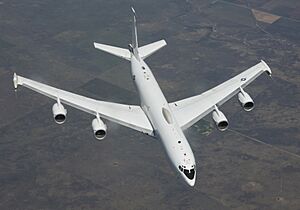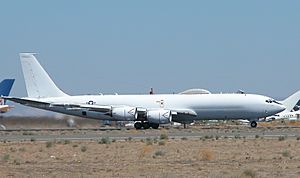Boeing E-6 Mercury facts for kids
Quick facts for kids E-6 Mercury |
|
|---|---|
 |
|
| Boeing E-6 Mercury | |
| Role | Airborne command and control |
| Manufacturer | Boeing |
| First flight | 19 February 1987 |
| Introduction | August 1989 |
| Status | Ceased production, in service |
| Primary user | United States Navy |
| Number built | 16 |
| Developed from | Boeing 707 |
The Boeing E-6 Mercury is a special airplane used by the United States Navy. It acts like a flying command center and a radio relay station. This means it helps send important messages. It's built from the Boeing 707-300 airliner.
The E-6 Mercury's main job is to send orders from the National Command Authority (which includes the President) to submarines that carry nuclear missiles. This mission is called TACAMO, which stands for "Take Charge And Move Out."
The E-6B model, which started flying in 1998, can also control Minuteman ICBMs (long-range missiles) from the air. It took over this role from other planes, making sure U.S. nuclear forces can always be controlled, even if ground stations are not working. The E-6 was the very last new version of the Boeing 707 ever built.
Contents
How the E-6 Mercury Was Designed and Built
The E-6 Mercury is based on the 707-320 airliner, just like the E-3 Sentry "AWACS" planes. The first E-6 was finished in December 1986. It made its maiden flight (first flight) in February 1987. After that, it was flown to Boeing Field to have its special mission equipment installed. The Navy received it for testing in July 1988.
The E-6B is an improved version of the original E-6A. It has a special area for a battle staff and better equipment for its missions. Later, the cockpit was updated with systems similar to those in the Boeing 737 Next Generation. This made it easier for pilots to fly and understand their surroundings. The first E-6B was ready in December 1997. All 16 E-6A planes were changed into the E-6B version, with the last one delivered in December 2006.
The E-6 cannot refuel in the air using the same method as most other U.S. Navy planes. It needs specific U.S. Air Force planes like the KC-135 Stratotanker to refuel it while flying.
The E-6 Mercury in Action
The E-6 is known by the codename Looking Glass. It serves as the United States Strategic Command's (USSTRATCOM) Airborne Command Post. This means it's designed to take over if the main ground control center is damaged or can't communicate. The name "Looking Glass" is used because the plane "mirrors" the abilities of the ground command center to control nuclear forces.
The E-6A, first called Hermes, began service with squadron VQ-3 in August 1989. Another squadron, VQ-4, received its first E-6As in January 1991. This allowed older planes to be retired. The E-6A was renamed Mercury in late 1991 at the Navy's request. Sixteen E-6A planes were delivered between 1988 and 1992.
The E-6 fleet is based at Tinker Air Force Base, Oklahoma. It is operated by VQ-3, VQ-4, and VQ-7.
In 2021, an E-3D Sentry plane from the Royal Air Force was bought. It will be changed into a special E-6 trainer aircraft. This helps extend the life of the working E-6 planes by reducing their use for training missions.
Future Plans: Replacing the E-6
In 2015, both the Air Force and Navy realized they would need new planes for their important missions. They first thought about building one plane to replace both the E-4 and E-6. However, by 2020, the Navy decided to develop its own plane specifically for the TACAMO mission.
This new Navy project is called the E-XX TACAMO. The Navy expects the E-XX to start being used in the late 2020s. The E-6 is planned to continue its TACAMO role into the 2030s as the new E-XX planes come into service.
Images for kids
See also
 In Spanish: Boeing E-6 Mercury para niños
In Spanish: Boeing E-6 Mercury para niños
- Aircraft related to this one
- Boeing 707
- Airborne Launch Control System
- Similar aircraft
- Boeing E-4
- Boeing EC-135
- Northrop Grumman E-10 MC2A
- Ilyushin Il-80
- Tupolev Tu-142MR
- Lists related to this aircraft
- List of active United States military aircraft




